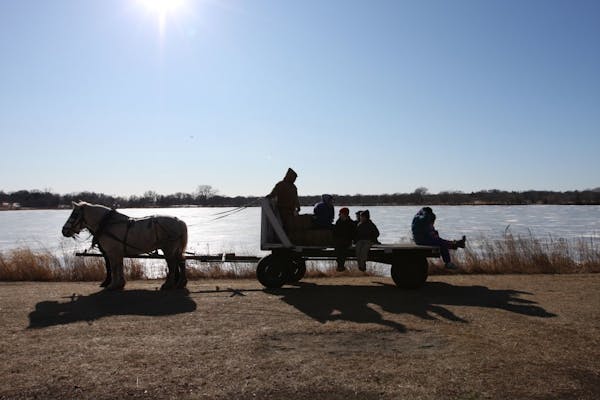Like the American West, Siberia was for centuries Russia's undeveloped wilderness, its forests and bogs home to nomadic hunters and herders, religious outcasts and political exiles. Both landscapes have undergone dramatic changes in the past 100 years in response to wide-ranging economic, political and environmental issues.
The parallels are sometimes sketchy, but the similarities can be startling as seen in "Siberia: Imagined and Reimagined," an intriguing show of more than 100 Russian photos dating from 1870 to the present. It runs through May 18 at the University of Minnesota's Weisman Art Museum.
If they think of Siberia at all, Americans may assume it is an eternal tundra, denuded of greenery, snow-covered, bleak and frozen in all seasons. That's as wrong about Siberia as it is about Minnesota.
Siberians, too, have mosquitoes — lots of them in the hot summers, when urbanites retreat to the forests and vast lakes of the region. One charming photo shows a girl twirling three hula hoops at a forested campsite that could be in Minnesota, except that her camp was sponsored by the Vissarions, a popular Siberian religious sect founded in 1991 by a former traffic cop who claims to be Christ reincarnate. Another image documents a long line of well-bundled Vissarions trudging through deep snow in a devout procession.
It's this strange mix of the seemingly familiar and the quixotic that makes these pictures so engrossing. They are greatly enhanced by lively, well-researched labels written by Laura Joseph, a Weisman curatorial fellow.
From Tsar through Stalin
Organized by the Foundation for International Arts and Education, a nonprofit based in Washington, D.C., "Siberia" is marked by a kind of National Geographic anthropological earnestness. Loosely divided into five sections, it begins in Czarist times when the Imperial Russian Geographic Society set out to document a territory that stretched more than 3,000 miles from the Ural Mountains to the Pacific.
History buffs will love early photos that include a studio image of nomadic hunter-gatherers in full hide-and-fur regalia, clutching bow and spear amid a clutter of bark containers and scrubby conifers in front of a dreamy painted backdrop. There are startling images of prisoners in newly forged chains, and surprises such as a color picture of a railway guard taken about 1910 by Sergey Prokhudin-Gorskii, a Russian chemist who invented a color process decades ahead of its time.
An intrepid photographer sought out "The House of the Decembrists," the whitewashed log home of a Russian prince banished to Siberia for trying to assassinate Czar Nicholas I in December 1825, a caper that sparked a revolutionary movement in Russia and — 175 years later — a popular folk-rock band from Portland, Ore.
From the 1917 revolution until Stalin's death in 1953, photography was used primarily to promote Soviet culture and values. Subsequently a more "realist" tone prevailed until the Soviet Union dissolved in 1991. Highlights of the propaganda section include a 1938 photo of two boys hauling on their shoulders an immense "100-year-old pike" from Lake Baikal and a bizarre image of uniformed Russian violinists and a singer serenading fur-clad Chukchi tribespeople on a hillside.
In keeping with Soviet ideology, ethnic distinctions were banished and native people were supposed to be assimilated into the dominant culture. Still, old ways survived into the 1980s when a photographer accompanied harpoon-wielding Chukchi tribesmen on a walrus hunt in a dory right out of "Moby Dick."
The post-Soviet era
The second half of the show features primarily color photos of the Post Realism era, 1991 to the present, when photographers were freed of government scrutiny and began choosing more personal subjects, documenting environmental degradation and introducing more skepticism and humor.
Anastasia Rudenko's 2010 photo "Krasnoyarsk," featuring five bikini-clad bathers on a snowy riverbank, suggests their tone as does her photo of shivering "Newlyweds," posing with their beribboned Honda in snow-covered suburban Novosibirsk, Russia's third-largest city. Alexander Gronsky's lyrical 2006 picture of lovely birch trees crowded tight against a frieze of new pastel apartment buildings poignantly juxtaposes old and new, nature and urban life, past and perhaps the inevitable future.
The fifth and final section really pulls the show together and, with a little amplification, could be a stand-alone exhibit. It features 20 photos that directly compare 10 American and 10 Russian images encompassing the same time span as the larger exhibit.
A 1903 ethnographic image of an Alaskan Inuit man in native anorak faces a similarly posed Russian Tangus woman from the same era; 1850s California gold miners are paired with their 1880s Russian counterparts on the Amur River; American guys build Hoover Dam in the 1930s, and Russians finish a hydropower station in 1972. Even American cowboys are juxtaposed with Kamchatka deer herders, a Utah uranium mine with a cyanide-laced Siberian mining pond, and Hollywood Boulevard with Lenin Square in Novosibirsk.
The formal similarities in the photos are riveting, the twinned images spanning time, politics and half the globe.
Mary.Abbe@startribune.com
612-673-4431

This retired journalist changed professional wrestling from Mankato

All-Metro Sports Awards: Here are the 2023 winners

